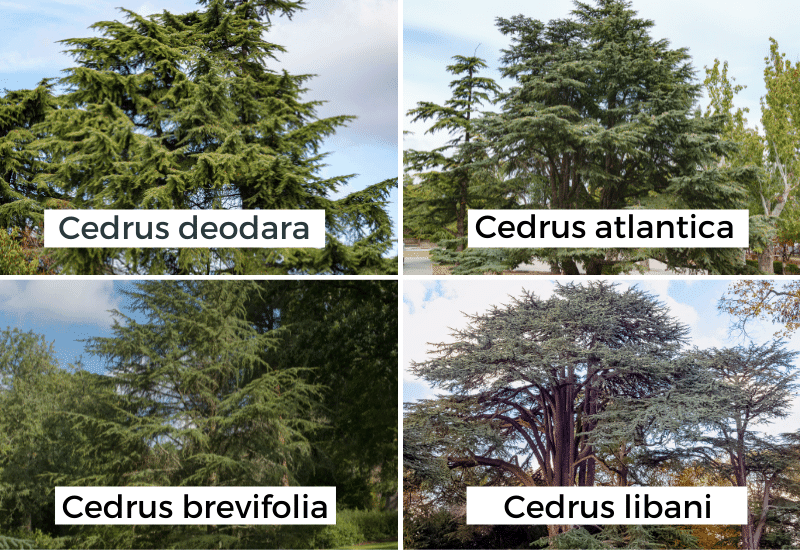
Cedar trees are are large evergreen conifers of the Pinaceae (pine) family native of high altitude mountains in the Himalayas and the Mediterranean.
Cedar trees can be identified by it’s evergreen foliage consists of short needles united in rosettes on the fragrant woody branches, a pyramidal then spreading habit, needle-shaped flowers as well as triangular and winged seeds.
The color of its evergreen foliage varies according to the species, but it is generally a light green-grey-bluish.
A symbol of majesty and longevity, and very much prized for landscaping in public and large private gardens. But there there is a series of dwarf varieties with golden and blue needles that are suitable for small gardens.
There are only four types of True Cedar Trees, Himalayan cedar, Atlas Cedar, Cyprus Cedar and Lebanon cedar. From these 4 species have been created many cultivars which differ in their adult size, the color of their foliage and their habit.
We will first learn how to identify any member of the Cedrus genus, and then we will find all the distinctions between different types of cedar trees (natural and cultivars) with a full identification guide.
Compiled below are distinct features of both true and false cedar species as well as tips on how to identify the various types in the world.
You will be able to recognize them all and even choose your favorite by the end of this article, but what by? Let’s read on…
How To Identify Cedar Trees
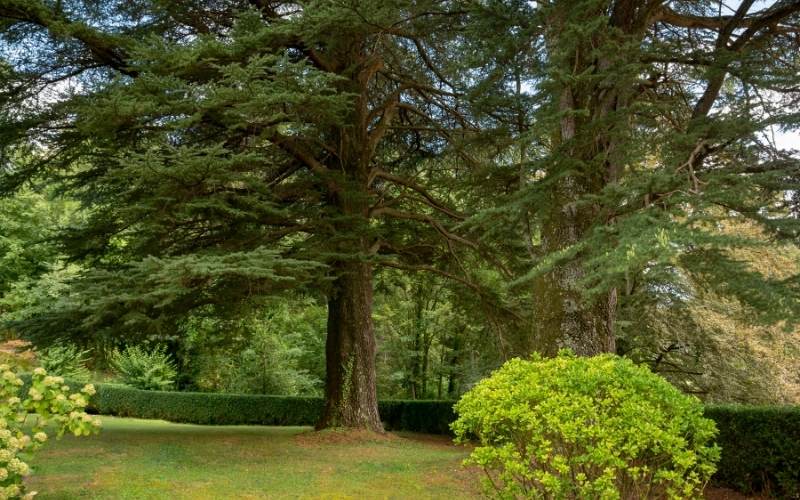
It is easy to confuse cedar trees of the Cedrus genus with pine trees, but they are not the same. There is a key distinction when it comes to the foliage, and other minor differences which we are going to see very soon.
Identify a Cedar Tree by the Needles
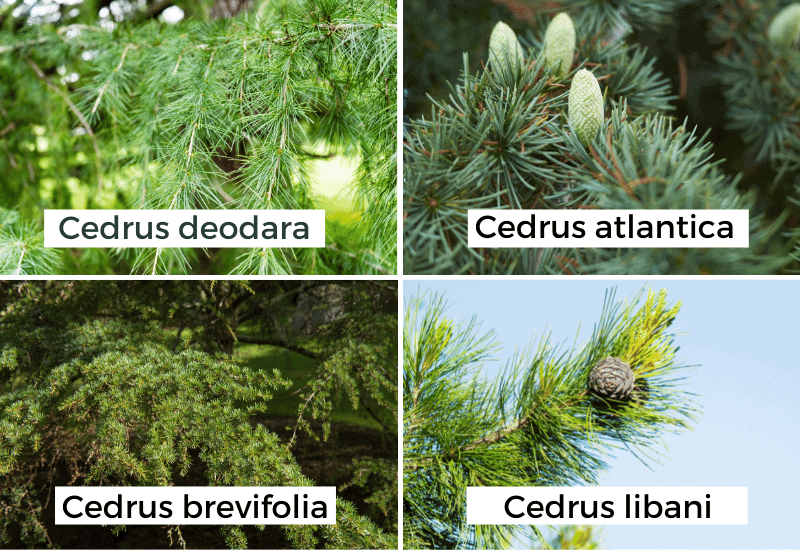
Like all conifers, cedar trees have needles rather than broad leaves, and they are evergreen. These can be 0.3 to 2.3 inches long (8 to 60 mm). This tells us that they are short, unlike in many pine trees and firs. And this is a a first telling sign that you are looking at a member of the Cedrus genus.
But if you really want to make sure, you need to look at how the needles are arranged and how they grow on the branch.
In fact, cedars have them arranged in what we call spiral phyllotaxis. And this is almost unique in all conifers. But what do we mean by this term? It means that they all come from the same central point, and that they firm a whorl, a thick spiral indeed.
They are attached to the branch with a fascicle, like with pines, and in each rosette you can find needles from different years, up to three.
The shape of the needle is also very distinctive; if you cut it in the middle, you get a cross section that is a triangular with curved sides, or in come cases squares.
The color can range, from dark green to blue green.
Identify a Cedar Tree by Its Cones
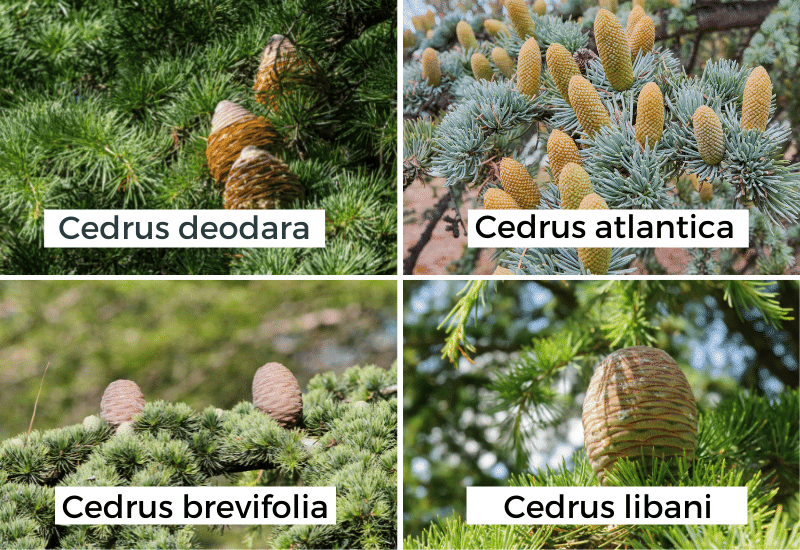
The cones of cedar trees point upwards on the branches, and they have thin and broad scales that intersect like in basket weaving.
They are usually large and barrel shaped, but there are some exceptions, like with deodar cedar (Cedrus deodara) which has long, and narrow cones with a diamond pattern of scales.
Cedar cones will disintegrate after they have dropped their seeds, and they are usually 2.3 to 4.7 inches long (6 to 12 cm) and 1.2 to 3.1 inches wide (3 to 8 cm). Firs can have much bigger ones.
While cedars look more like pines, their cones are similar to those of firs; they are also paper like like in Abies (fir), rather than woody, like in pines. This is especially noticeable when they open, while when they are young, they may look like small green pineapples.
So, if you see a tree with the shape of a pine, but the cones of a fir, it’s a cedar.
Identify a Cedar Tree by Its Size
Cedar trees are never small when adult. They range between 100 and 210 feet tall (30 to 210 meters). They will mainly keep within the 120 feet in height (40 meters), but there are some real giants. If you see a short cedar looking tree, it is a pine…
The spread of cedars can reach 80 feet in spread (24 meters), though most will be narrower. The dimensions of this conifer mean that you cannot grow one in a small space; but it also gives them impressive landscaping qualities, in fact…
However, cultivars are smaller, sometimes even dwarf in size.
This is part of why they look majestic, but not the only one, the other is their shape.
Identify a Cedar Tree by Its Shape
True cedars have a very distinctive shape; they are monopodial, which means that the main trunk keeps growing as it produces lateral branches.
These are spaced, and with rhythmic regularity. They have a special trait though; the Cedrus genus has primary and secondary shoots. The latter carry most of the leaves, while the larger ones are virtually barren.
This, and the open habit of our conifers give cedars the effect of “clouds of leaves” that so well adapts to Japanese and oriental gardens, but not only.
The shape of the crown can vary; in some varieties, it is conical, while in others, like in cedar of Lebanon (Cedrus libani) it is spreading.
Perfect, now you know how to tell a cedar tree from other conifers, let’s discuss what you need to look at to distinguish the different taxa (varieties) within the genus.
4 Types Of True Cedar Trees
There are only 5 real types of cedar trees, as we said; we won’t lose time on the technical issue of why they are called “taxa” and not “species”, but I want to help you read the description with identification in mind…
But only of 4 of them, because one, Cedrus penzhinaensis is unfortunately extinct.
What will we be looking at? Apart from a general description, origin etc., we will look at some of the same elements we did in the previous section, those that help us tell one type of cedar tree from another: size, needles, shape, cones and other distinctive features if necessary.
Ready? Off we go!
1: Cedar of Lebanon (Cedrus libani)
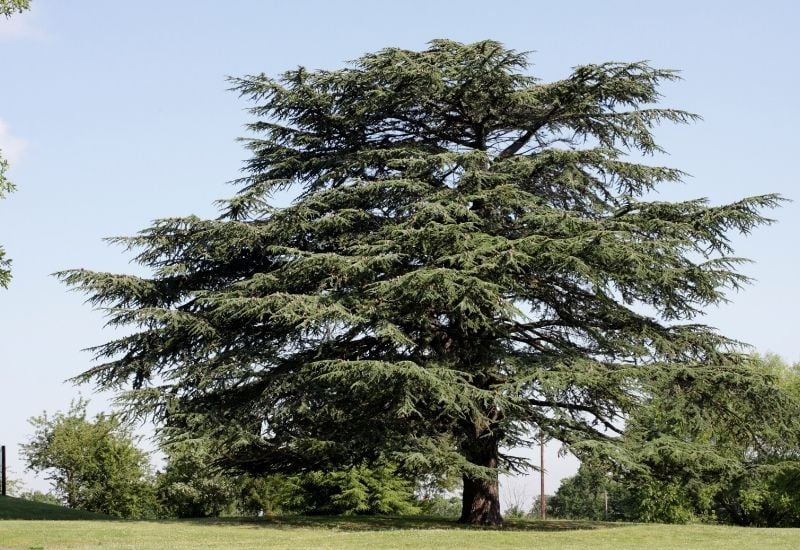
Cedar of Lebanon is one of the most famous cedar tree varieties, you can identify it by its striking shape and original of the Eastern Mediterranean region.
In fact, it will have a pyramidal shape when young, but as it grows, it will turn into a flat topped, spreading giant. It is in fact one of the broadest of all the genus Cedrus, reaching 60 feet (18 meters).
The trunk can reach 8.5 feet in diameter (2.5 meters). The branching is also very individual; these grow outward and they form iconic “clouds” over a large space. As it grows, the crown becomes more open, gaining more and more in landscaping value.
The cones are russet in color with smooch scale up to 4 inches long (10 cm). However, it will not produce any cones until it reaches the age of 40.
But even on a small scale, this tree is distinctive; the needles have four sides, they are short (0.4 to 1.1 inch long, or 10 to 25 cm), and they are dark green or glaucous bluish green in color. They can stay in the branches for up to 6 years.
It has won the Award of Garden Merit by the Royal Horticultural Society and it is arguably the most sought after cedar tree by gardeners.
2: Atlas Cedar (Cedrus atlantica)
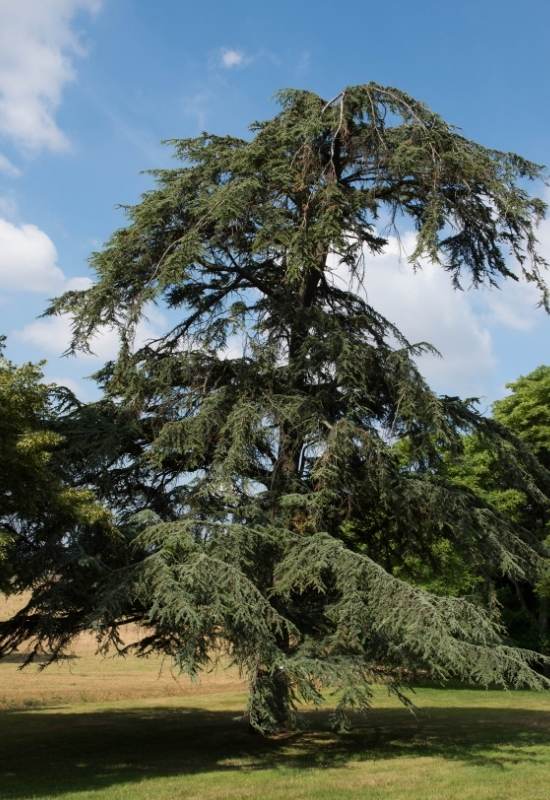
Atlas cedar comes from Morocco and it too has a majestic shape that distinguishes it and that makes it ideal for parks and large gardens.
Cedrus atlantica usually has an open pyramidal shape, with large branches that tend to grow up and out, some so large that they compete with the main trunk.
Adults form “clouds of leaves” that sometimes weigh down the lower branches. It can grow to 115 feet easily (35 meters) and sometimes even a bit taller. The trunk is large, up to 7 feet in diameter (2.1 meters). Overall, it looks taller and narrower than cedar of Lebanon.
The needles of Cedrus atlantica are dark green to glaucous blue and in numerous rosettes of up to 35. The cones are brown in color and they rarely exceed 3.6 inches long (9.0 cm).
Atlas cedar is an endangered species in natural environment on the Atlas Mountain Range, but it has become very popular with gardeners, and they have generated a few cultivars, which we will see later on.
3: Cyprus Cedar (Cedrus brevifolia)
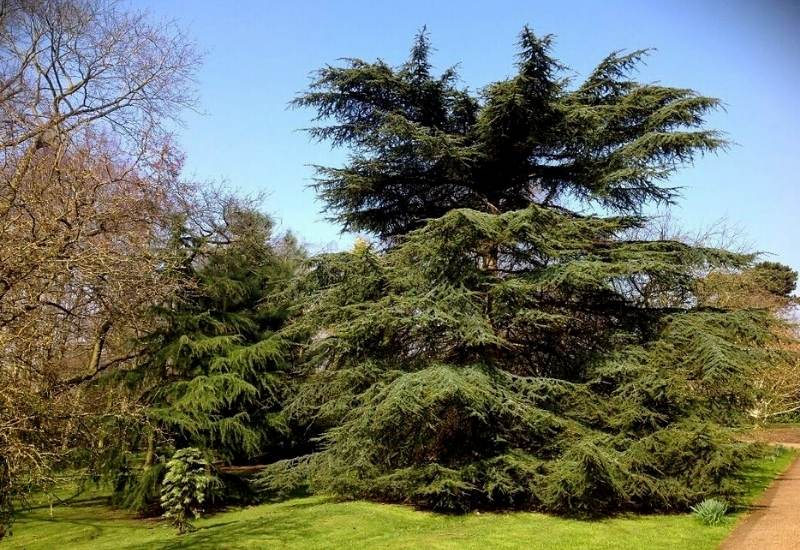
You can easily recognize a Cyprus cedar because it looks far more like a fir tree than other varieties, but only when it is young. It originates from the Troodos Mountains on the famous island in the East Mediterranean Sea.
Cedrus brevifolia is closely related to Cedar of Lebanon and in fact some people confuse them, and some even think they are the same.
It is shorter than Lebanon or Atlas cedars, reaching 60 feet tall (20 meters) and it’s the slowest growing of all members of this genus.
The overall shape is conical, and the branches are short and with a horizontal spread, and for this reason it looks like Abies.
However, this changes as it matures and it ends up with a flat umbrella crown.The needles range between 0.2 and 0.35 inches (5 to 8 mm) and they are blue green in color. The cones are distinctive, with a large protuberance and a concave upper part, or apex, and short, only 2.8 inches long (7.0 cm).
Cyprus cedar is not a common variety in gardens, but it still has the imposing beauty of these trees. And if you want to grow it, here are a few ideas for you…
4: Himalayan Cedar (Cedrus deodara)
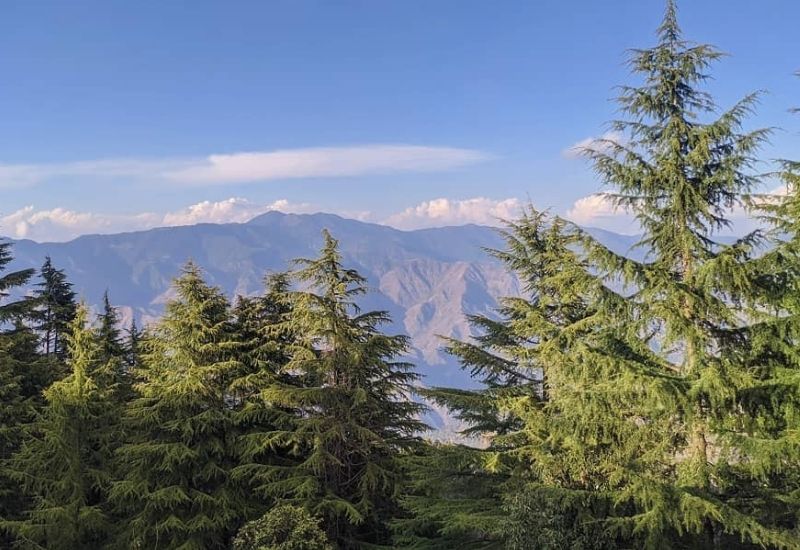
Deodar cedar comes from the Himalayas, easy to identify because it’s a real giant, growing up to 200 feet tall (60 meters) and with a trunk that can reach 10 feet in diameter (3.0 meters).
It has fairly long needles for this species (up to 7.0 cm, or 2.8 inches but usually smaller) in rosettes of 20 to 30.
Their color ranges from bright green to glaucous and pale green, The cones are 2.8 to 5.1 inches long (7.0 to 13 cm) and broad, between 2.0 and 3.5 inches (5 to 9 cm) and barrel shaped. It has a pyramidal crown, and it retains this shape into maturity.
The branches grow outwards more frequent on the branches than in other varieties, especially when young. It is prized for its wood and used in Ayurvedic medicine.
Deodar cedar is not a common variety for gardening; its size makes it hard to keep in gardens, and it does not have the same decorative value of Lebanon cedars, because its shape can easily be replaced by fir trees, which grow faster, they are cheaper and often smaller.
However, there the cultivars of Cedrus we grow in gardens, are all derived from this mother species. But just in case, here is how to grow it.
Best Cedar Varieties For Home Landscaping
Deodar cedar is not ideal for gardens, but its offspring of cultivars is. And even Atlas cedar has given us some lovely cultivars that we want to get to know.
These are much smaller than the mother tree and breeders have been able to bring out amazing features, like colored foliage and unusual, decorative shapes. Let’s see them…
5: Deodar Cedar ‘Aurea’ (Cedrus deodara ‘Aurea’)
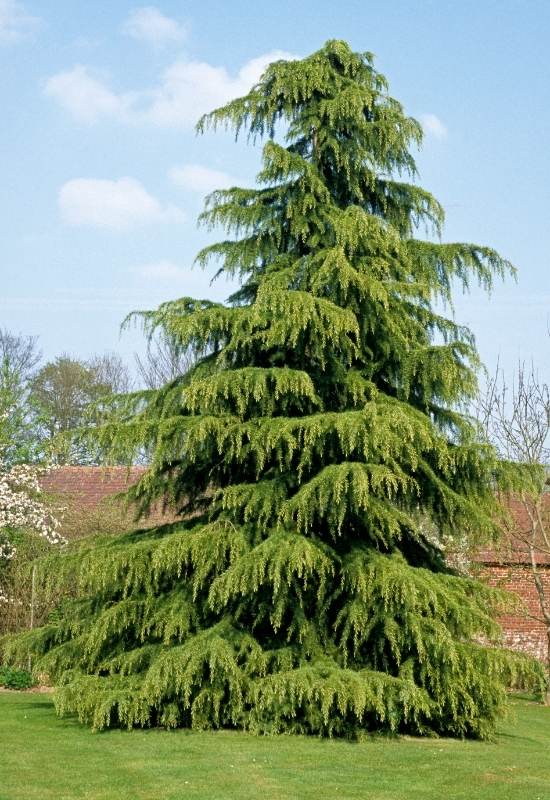
‘Aurea’ is a very decorative cultivar of deodar cedar you can identify thanks to its name: in Latin, it means “golden” and this describes its foliage. In fact, the first thing that will strike you is color of the needles, which are light green with golden yellow shades in them.
This is quite unique in our group of conifers. The branches are fairly dense, like in the mother species, short and with horizontal growth. The foliage hangs softly on them draping at the tips.
The overall shape is conical, with the crown starting quite low down the trunk. It is garden size cedar, bred on purpose, as it only reaches 40 feet in height maximum (12 meters).
‘Aurea’ deodar cedar is ideal for informal gardens, as a specimen plant or in clumps; it will look great in city and courtyard gardens, cottage and English country designs, and it has won the Award of Garden Merit by the Royal Horticultural Society.
6: Deodar Cedar ‘Feelin’ Blue’ (Cedrus deodar ‘Feelin’ Blue’)
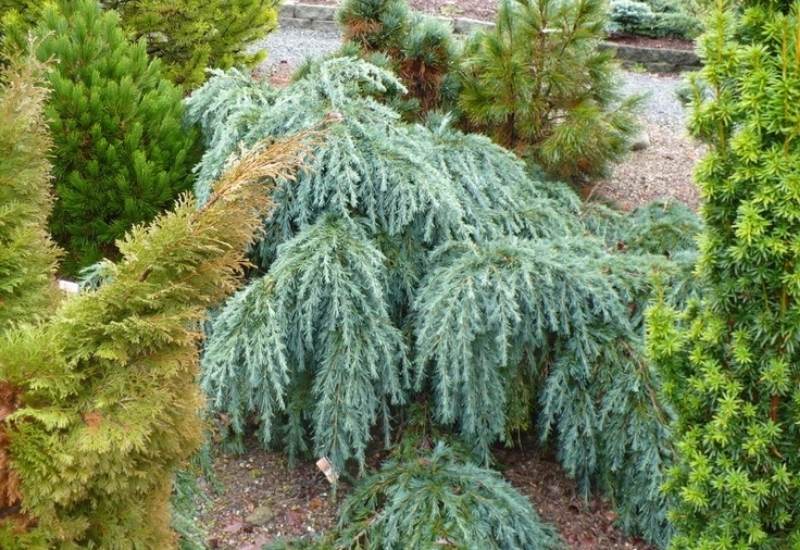
You will recognize ‘Feelin’ Blue’ deodar cedar because it is very small. It is only 3 feet tall (90 cm), a far cry from the colossal conifers we usually identify with the name Cedrus.
This goes to the credit of amazing breeders, and it also has other great characteristics for gardening.
The foliage is blue, or aquamarine, and dense. It has a flat and round habit, quite dense and with lovely arching branches.
It is bigger in spread than height… Indeed, it does not look like any other cedar tree, and you could confuse it for a shrub. In fact, unless you train it, using a stake to lift it up, it will remain short, large and bushy.
‘Feelin’ Blue’ deodar cedar is perfect in hedges, for foundation planting and even as ground cover.
It adapts to all informal designs, including cottage gardens, urban settings and even oriental and Japanese designs. It has won the Award of Garden Merit by the Royal Horticultural Society.
7: Atlas Cedar ‘Glauca’ (Cedrus atlantica ‘Glauca’)
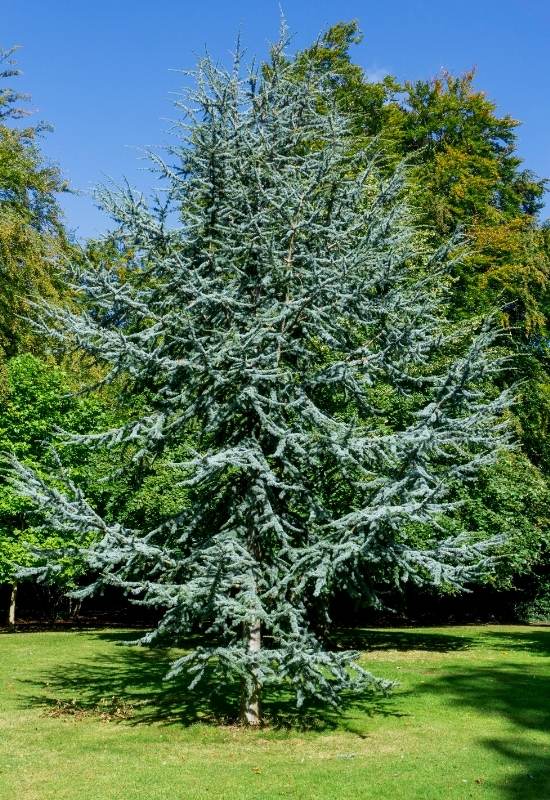
‘Glauca’ is garden cultivar of Atlas cedar with a very distinctive “barren” look you can easily identify it by. When it is young, it has a long and thin trunk with few, short horizontal branches on it.
Each branch is clearly separate from the others, isolated and visible. Oddly enough, they are all covered by needles that coat them, but only just.
These will become thicker and thicker as the plant matures, giving you a final pyramidal crown when it is an adult.
The color of the needles is striking too: it is silver blue, and so unique in this genus of conifers. It is also a fast growing plant, up to 24 inches each year (60 cm) but it will never become too tall, maximum 60 feet (18 meters).
Atlas cedar ‘Glauca’ is a perfect garden tree; it is excellent for all informal garden designs, and you can have color, texture and structure in a short time with it. It has won the Award of Garden Merit by the Royal Horticultural Society.
8: ‘Golden Horizon’ Deodar Cedar (Cedrus deodar ‘Golden Horizon’)
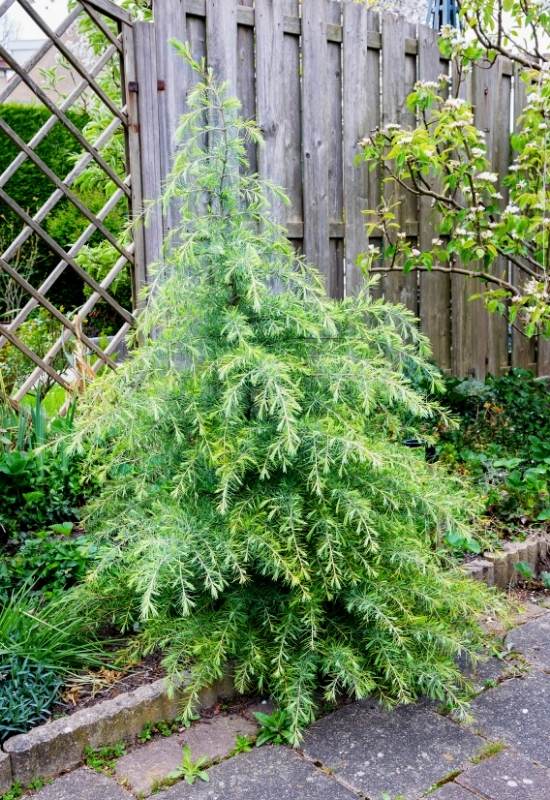
‘Golden Horizon’ is a deodar cedar cultivar similar to ‘Aurora’ but the main difference is its smaller size. In fact it only grows to a maximum of 10 feet (3.0 meters).
The needles are green most of the year, but in summer they turn golden green. It has long, horizontal main branches with arching, almost weeping secondary branches.
This gives it a very soft, elegant look. What is more, it is very broad at the base and it tapers to a tip giving you a large pyramidal shape.
The foliage is thick and the habit is dense, so you can hardly see the branches beneath it. In a way, it looks like a large shrub with an almost prostrate habit.
‘Golden Horizon’ deodar cedar is perfect to give you lots of fresh and bright texture and foliage in most types of informal gardens, as a specimen plant or in clumps, or even to clock an unsightly corner of your yard or beyond it.
9: Atlas Cedar ‘Glauca Pendula’ (Cedrus atlantica ‘Glauca Pendula’)
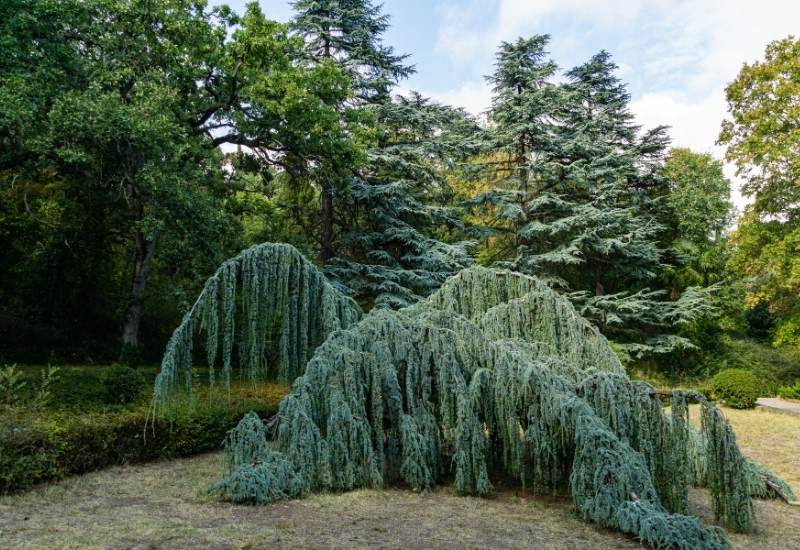
It is easy to recognize Atlas cedar ‘Glauca Pendula’ because it has weeping branches. The trunk is straight and upright; the primary shoots are horizontal and bare. But the secondary branches that grow from them grow downwards, like on a willow tree.
These are wrapped in a short “fuzz”’of blue needles, and they almost touch the ground. And you can also train them to make winding shapes, like snakes… In fact, you can train the whole tree to follow arches, porches and gates, as if it was a climber.
This very original variety of Cedrus has won the Award of Garden Merit by the Royal Horticultural Society.
Atlas cedar ‘Glauca Pendula’ is a very valuable garden tree; you can shape it as you wish and it has a natural picturesque appearance. Add the unusual shade of its short needles, and you can see how it can really transform a green space, and it adapts to all themes, from Mediterranean to Japanese.
10: Cyprus Cedar ‘Kenwith’ (Cedrus brevifolia ‘Kenwith’)
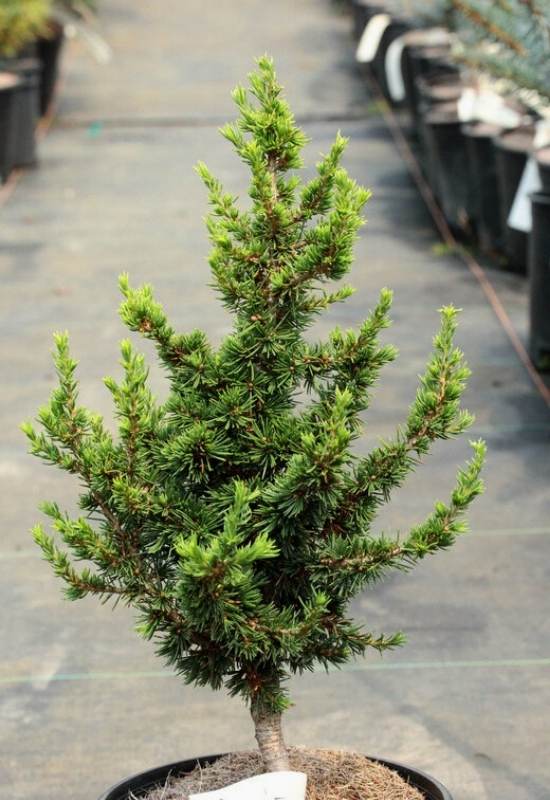
It is easy to identify the cultivar of Cyprus cedar named ‘Kenwith’: it is the smallest of all cedar trees! In fact, it looks like a miniature version of its majestic relatives, reaching a maximum height of only 18 inches (45 cm)! And because it is slow growing, it will take it a whole 10 years to reach this modest size.
This dwarf cyprus cedar has a thick and pyramidal habit, with branches that start low down on the truck and they point clearly up. This too is an unusual feature.
The foliage is dense and bright green, making it a diminutive but lively presence in gardens.
Cyprus cedar ‘Kenwith’ is perfect for small spaces, even containers on terraces or patios.
It is also a natural bonsai, and its shape makes it ideal for foundation planting, to have evergreen foliage and textures in hedges and even to decorate the sides of paths.
Cedar Giants And Cedar Dwarves Identified!
Well done! Now you can identify all the 4 taxa, or main varieties of cedar trees and even their 6 cultivars, from towering giants like deodar cedar or cedar of Lebanon to lilliputian cultivars like ‘Kenwith’, and maybe one can find a home in your garden, or even on your terrace.

Written By
Amber Noyes
Amber Noyes was born and raised in a suburban California town, San Mateo. She holds a master’s degree in horticulture from the University of California as well as a BS in Biology from the University of San Francisco. With experience working on an organic farm, water conservation research, farmers’ markets, and plant nursery, she understands what makes plants thrive and how we can better understand the connection between microclimate and plant health. When she’s not on the land, Amber loves informing people of new ideas/things related to gardening, especially organic gardening, houseplants, and growing plants in a small space.

Thanks for the info. I would like which cedar is effective on moth and other insects. Any medical importance of trees mentioned?